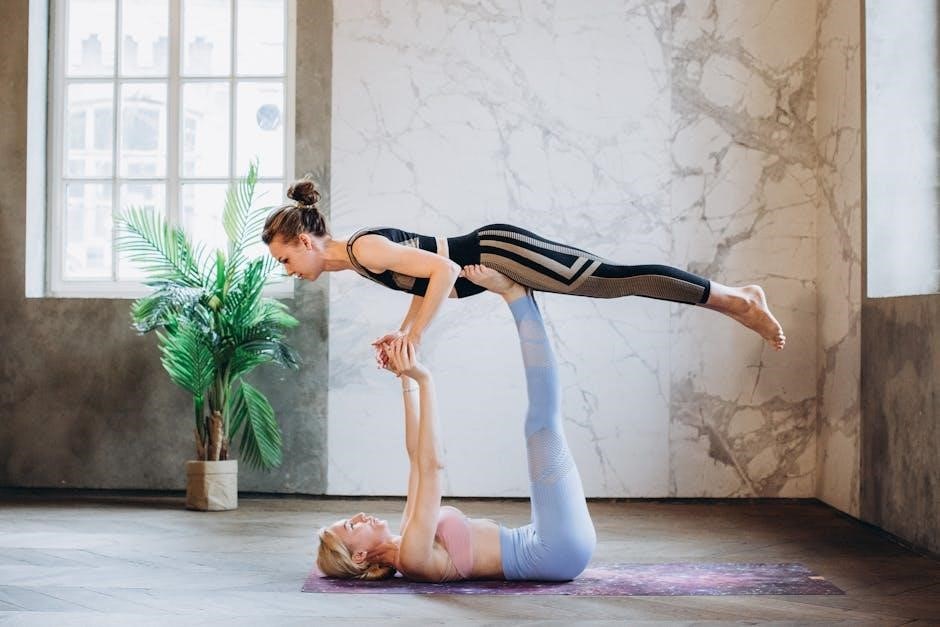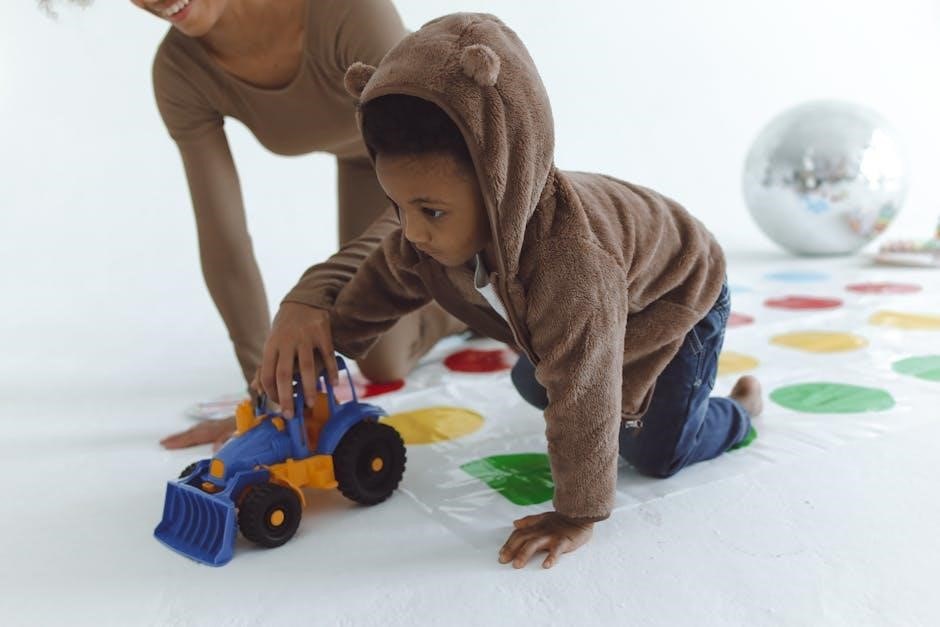Proprioceptive activities are exercises that enhance body awareness and coordination, improving balance and motor skills. They engage the senses through movement, providing feedback from muscles and joints, essential for daily functioning and overall physical stability.
1.1 Overview of Proprioception
Proprioception is the body’s ability to sense its position, orientation, and movement in space. It is a vital sensory system that provides feedback from muscles, tendons, joints, and ligaments, enabling precise coordination and balance. This sense is essential for everyday activities, such as walking, running, or even maintaining posture. Proprioception helps the brain understand how much force to apply during movements, ensuring smooth and efficient action; It is also crucial for learning new motor skills, as it provides the necessary feedback for the brain to adjust and refine movements. In children, proprioception plays a key role in development, while in athletes, it enhances performance. Damage to this system can lead to challenges in coordination and stability, highlighting its importance in overall physical function and rehabilitation.
1.2 Importance of Proprioceptive Activities
Proprioceptive activities are crucial for improving balance, coordination, and overall motor skills. They help individuals develop body awareness, enhancing their ability to navigate environments with precision. For children, these activities are essential for developmental milestones, such as walking and running, while for athletes, they refine performance and reduce injury risk. In rehabilitation settings, proprioceptive exercises aid recovery by restoring movement and stability after injuries or surgeries. Additionally, they benefit individuals with sensory processing challenges by providing calming and organizing input. Regular engagement in these activities promotes better posture, reduces clumsiness, and enhances daily functioning, making them a valuable tool for maintaining physical and sensory well-being across all age groups and abilities.

Types of Proprioceptive Activities
Proprioceptive activities include heavy work, outdoor exercises, and animal walks. They involve resistance, stretching, and balance challenges, helping improve body awareness and coordination through varied movements and sensory input.
2.1 Heavy Work Activities
Heavy work activities, such as carrying objects, pushing, or pulling, provide deep sensory input to muscles and joints. These exercises enhance proprioception by engaging the body in resistance-based movements, improving strength and coordination. Examples include carrying heavy books, dragging a weighted bag, or using resistance bands. These activities are particularly beneficial for individuals seeking to improve their balance and overall physical stability through targeted, intense movements that stimulate the proprioceptive system.
2.2 Outdoor Activities
Outdoor activities are excellent for enhancing proprioception, as they often involve dynamic movements and varied environments. Climbing, such as using monkey bars or jungle gyms, strengthens muscles and improves coordination. Trampolines provide repetitive bouncing, which stimulates the sensory system. Activities like jumping over obstacles or walking on uneven terrain challenge balance and spatial awareness. Playing games that involve running, dodging, or kicking balls also engage the proprioceptive system. Outdoor settings offer natural resistance and unpredictability, making these activities highly effective for improving sensory integration and motor skills. These exercises are not only fun but also provide a comprehensive workout for the body’s proprioceptive system, helping individuals develop better control over their movements and overall physical stability.
2.3 Animal Walks and Stretching Exercises
Animal walks and stretching exercises are engaging and effective proprioceptive activities. Bear crawls, crab walks, and frog jumps mimic animal movements, strengthening muscles and enhancing coordination. These exercises challenge balance and encourage the body to adapt to different positions. Stretching exercises, such as using resistance bands or Therabands, provide gentle yet effective proprioceptive input. Activities like stretching squidgy toys or playing with stress balls also engage the sensory system. These exercises are versatile and can be adapted to various ages and abilities, making them ideal for both children and adults. Regular practice improves flexibility, posture, and overall sensory integration, while also fostering creativity and physical awareness through playful movement.
Proprioceptive Exercises for Specific Needs
Proprioceptive exercises tailored to specific needs, such as sensory diets, chair exercises, and oral motor games, help improve balance, focus, and motor skills for individuals with unique requirements.
3.1 Sensory Diets and Heavy Work
Sensory diets and heavy work activities are tailored to meet specific sensory needs, enhancing proprioception and overall motor function. These structured routines provide consistent sensory input, helping individuals regulate their responses to environmental stimuli. Heavy work, such as carrying objects or pushing, engages the muscles and joints, offering deep proprioceptive feedback. Activities like washing desks or using resistance bands are effective examples. Sensory diets incorporate these exercises into daily schedules, ensuring regular stimulation. This approach is particularly beneficial for those with sensory processing challenges, improving focus, emotional regulation, and physical coordination. By combining purposeful movements with sensory integration, heavy work and sensory diets create a balanced foundation for motor skill development and overall well-being.
3.2 Chair Exercises and Push-Ups
Chair exercises and push-ups are excellent proprioceptive activities that strengthen muscles and enhance body awareness. Chair push-ups, tricep dips, and wall push-ups are simple yet effective, requiring minimal equipment. These exercises engage the arms, shoulders, and core, providing deep sensory feedback. By performing controlled movements, individuals improve joint stability and coordination. Push-ups, in particular, challenge balance and proprioception, as they require maintaining proper body alignment. These exercises are versatile, suitable for home, school, or office settings, making them ideal for incorporating into daily routines. Regular practice enhances motor skills, posture, and overall physical stability, while also boosting confidence in performing everyday tasks. Their accessibility and effectiveness make them a cornerstone of proprioceptive training programs.

3.3 Oral Motor Games and Messy Play
Oral motor games and messy play are engaging proprioceptive activities that stimulate the senses and enhance motor skills. Activities like blowing bubbles, whistling, or drinking thick liquids through a straw improve oral coordination and sensory integration. Messy play, such as manipulating rice, Skittles, or stretchy toys, provides tactile feedback, encouraging exploration and fine motor development. These exercises are particularly beneficial for children, as they foster creativity and sensory processing. Oral motor games also strengthen facial muscles and articulation, while messy play enhances hand-eye coordination and dexterity. Both activities can be adapted to different skill levels, making them accessible for various needs. Incorporating these into daily routines supports overall sensory development and motor precision, making them valuable tools for proprioceptive training programs. Their interactive nature ensures learning and growth through playful, engaging experiences.

Advanced Proprioceptive Techniques

Advanced proprioceptive techniques include tandem stance, single-leg balance, and Proprioceptive Neuromuscular Facilitation (PNF). These exercises enhance balance, coordination, and muscle control, offering deeper sensory integration and improved motor precision.
4.1 Tandem Stance and Single-Leg Balance
Tandem stance and single-leg balance exercises are advanced proprioceptive techniques that challenge equilibrium and refine sensory-motor integration. In tandem stance, the individual places one foot directly in front of the other, heel to toe, and maintains balance. This exercise enhances the body’s ability to process positional feedback from joints and muscles. Single-leg balance involves standing on one leg while keeping the other foot lifted, often with eyes closed for added difficulty. These activities strengthen the connection between sensory input and motor responses, improving coordination and reducing the risk of falls. Over time, they can be modified by adding movements, such as reaching or head turns, to further challenge balance and proprioceptive awareness. Both exercises are highly effective for individuals seeking to advance their balance skills and are commonly used in physical therapy and sports training programs.
4.2 Proprioceptive Neuromuscular Facilitation (PNF)
Proprioceptive Neuromuscular Facilitation (PNF) is an advanced technique that enhances neuromuscular coordination and strength by stimulating proprioceptors. It involves specific patterns of muscle contractions and stretches, often performed with a partner or therapist. PNF helps improve joint stability, flexibility, and overall motor control. By activating the body’s proprioceptive pathways, it facilitates voluntary movement and enhances functional abilities. This method is widely used in rehabilitation settings to restore mobility and strength after injuries or surgeries. PNF exercises can be adapted to various fitness levels, making them versatile for both therapeutic and performance enhancement purposes. Regular practice of PNF techniques promotes better body awareness and efficiency in daily activities, contributing to long-term physical well-being and athletic performance.

Leave a Reply